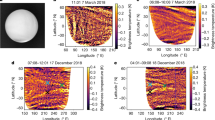Abstract
The Doppler Wind Experiment on the Galileo probe provided the first in situ data on wind speeds in Jupiter's atmosphere. Initial analysis1 of the results indicated that wind speeds increase with depth, rather than decaying to zero below the cloud tops or remaining relatively constant as had previously been assumed2. But this earlier analysis was subject to several potential sources of error, as highlighted by the fact that wind speeds measured at the cloud tops did not seem to match those inferred from tracking clouds3 in images obtained by the Voyager spacecraft. Here we report new analyses of the probe data that use a corrected treatment of the timing errors, adopt the measured4 (rather than predicted) descent trajectory, and incorporate a new calibration of the instrumentation that takes into account the unexpectedly high temperatures encountered by the probe. We determine wind speeds at the cloud tops (700-mbar level) in the range 80–100 m s−1, in agreement with the results of cloud tracking; the speed increases dramatically between 1 and 4 bar, and then remains nearly constant at ∼170 m s−1down to the 21-bar level. The increase in wind speed implies a latitudinal density gradient of 0.5% per degree in the 1–2 bar altitude range, but whether these winds are driven by internal heat or absorbed sunlight remains uncertain.

Similar content being viewed by others
References
Atkinson, D. H., Pollack, J. B. & Seiff, A. Galileo Doppler measurements of the deep zonal winds at Jupiter. Science 272, 842–843 (1996).
Pollack, J. B., Atkinson, D. H., Seiff, A. & Anderson, J. D. Retrieval of a wind profile from the Galileo probe telemetry signal. Space Sci. Rev. 60, 143–178 (1992).
Limaye, S. S. Jupiter: new estimates of the mean zonal flow at the cloud level. Icarus 65, 335–352 (1986).
Seiff, A. et al. Structure of the atmosphere of Jupiter: Galileo probe measurements. Science 272, 844–845 (1996).
Ingersoll, A. P. et al. Interaction of eddies and mean zonal flow on Jupiter as inferred from Voyager 1 and 2 images. J. Geophys. Res. 86, 8733–8743 (1981).
Orton, G. et al. Earth-based observations of the Galileo probe entry site. Science 272, 839–840 (1996).
Beebe, R. F., Simon, A. A. & Huber, L. F. Comparison of Galileo probe and Earth-based translation rates of Jupiter's equatorial clouds. Science 272, 841 (1996).
Seiff, A. et al. Wind speeds measured in the deep jovian atmosphere by the Galileo probe accelerometers. Nature 388, 650–652 (1997).
Folkner, W. M. et al. Earth-based radio tracking of the Galileo probe for Jupiter wind estimation. Science 275, 644–646 (1997).
Hess, S. L. & Panofsky, H. A. in Compendium of Meteorology (ed. Malone, T. F.) 391–398 (Am. Meteorol. Soc., Boston, 1951).
Ingersoll, A. P. & Cuzzi, J. N. Dynamics of Jupiter's cloud bands. J. Atmos. Sci. 26, 981–985 (1969).
Williams, G. P. Jovian dynamics. Part I: vortex stability, structure, and genesis. J. Atmos. Sci. 53, 2685–2734 (1996).
Ingersoll, A. P. & Cuong, P. -G. Numerical model of long-lived jovian vortices. J. Atmos. Sci. 38, 2067–2076 (1981).
Busse, F. H. Asimple model of convection in the jovian atmosphere. Icarus 29, 255–260 (1976).
Ingersoll, A. P. & Pollard, D. Motion in the interiors and atmospheres of Jupiter and Saturn: scale analysis, anelastic equations, barotropic stability criterion. J. Atmos. Sci. 52, 62–80 (1982).
Dowling, T. E. Estimate of Jupiter's deep zonal-wind profile from Shoemaker–Levy 9 data and Arnol'd's second stability criterion. Icarus 117, 439–442 (1995).
Poincaré, H. Sur la Précession des corps déformables. Bull. Astron. 27, 231–356 (1910).
Gierasch, P. J., Conrath, B. J. & Magalhaes, J. O. Zonal mean properties of Jupiter's upper troposphere from Voyager infrared observations. Icarus 67, 456–483 (1986).
Sromovsky, L. A. et al. Solar and thermal radiation in Jupiter's atmosphere: initial results of the Galileo probe net flux radiometer. Science 272, 851–854 (1996).
Ingersoll, A. P. & Porco, C. C. Solar heating and internal heat flow on Jupiter. Icarus 35, 27–43 (1978).
Dowling, T. E. & Ingersoll, A. P. Jupiter's great red spot as a shallow water system. J. Atmos. Sci. 46, 3256–3278 (1989).
Kirk, R. L. & Stevenson, D. J. Hydromagnetic constraints on deep zonal flow in the giant planets. Astrophys. J. 316, 836–846 (1987).
Acknowledgements
We thank the Galileo Project and NASA's Planetary Atmospheres Program. This work was supported by NASA.
Author information
Authors and Affiliations
Corresponding author
Rights and permissions
About this article
Cite this article
Atkinson, D., Ingersoll, A. & Seiff, A. Deep winds on Jupiter as measured by the Galileo probe. Nature 388, 649–650 (1997). https://doi.org/10.1038/41718
Received:
Accepted:
Issue Date:
DOI: https://doi.org/10.1038/41718
- Springer Nature Limited
This article is cited by
-
Atmospheric Science Questions for a Uranian Probe
Space Science Reviews (2024)
-
In Situ exploration of the giant planets
Experimental Astronomy (2022)
-
Reference Model Payload for Ice Giant Entry Probe Missions
Space Science Reviews (2020)
-
Plumbing the depths of Uranus and Neptune
Nature (2013)





